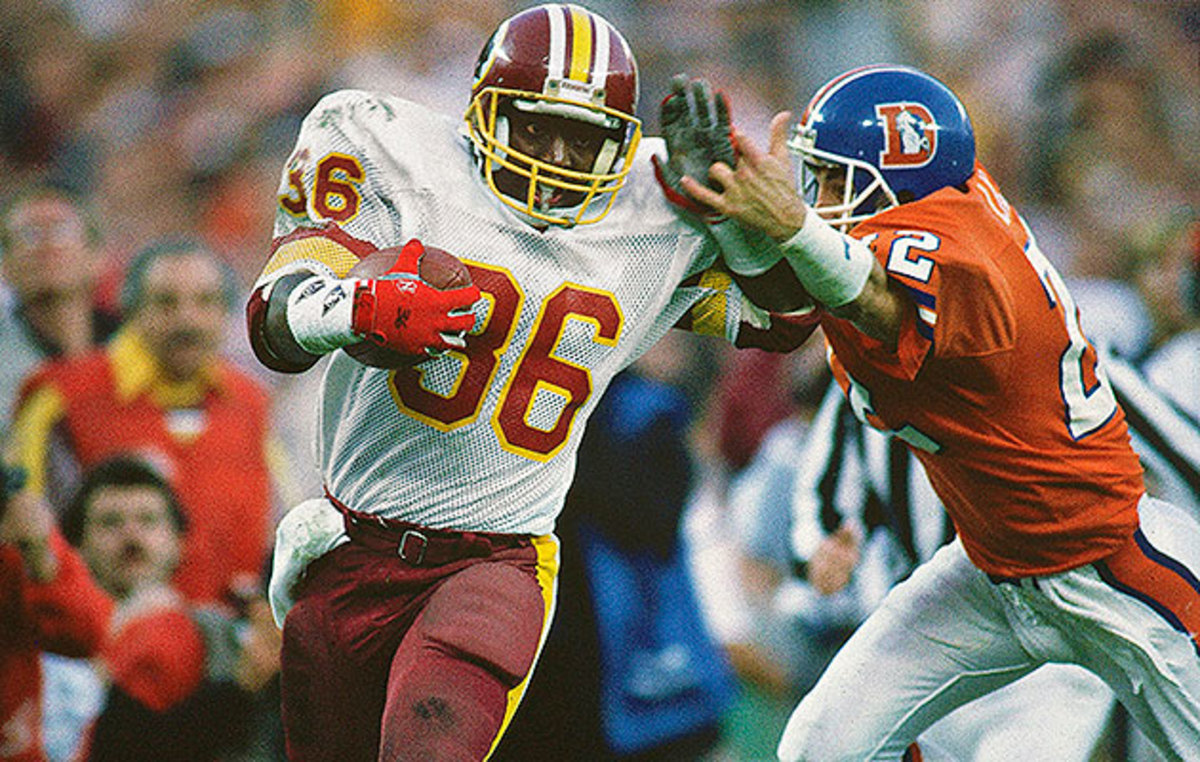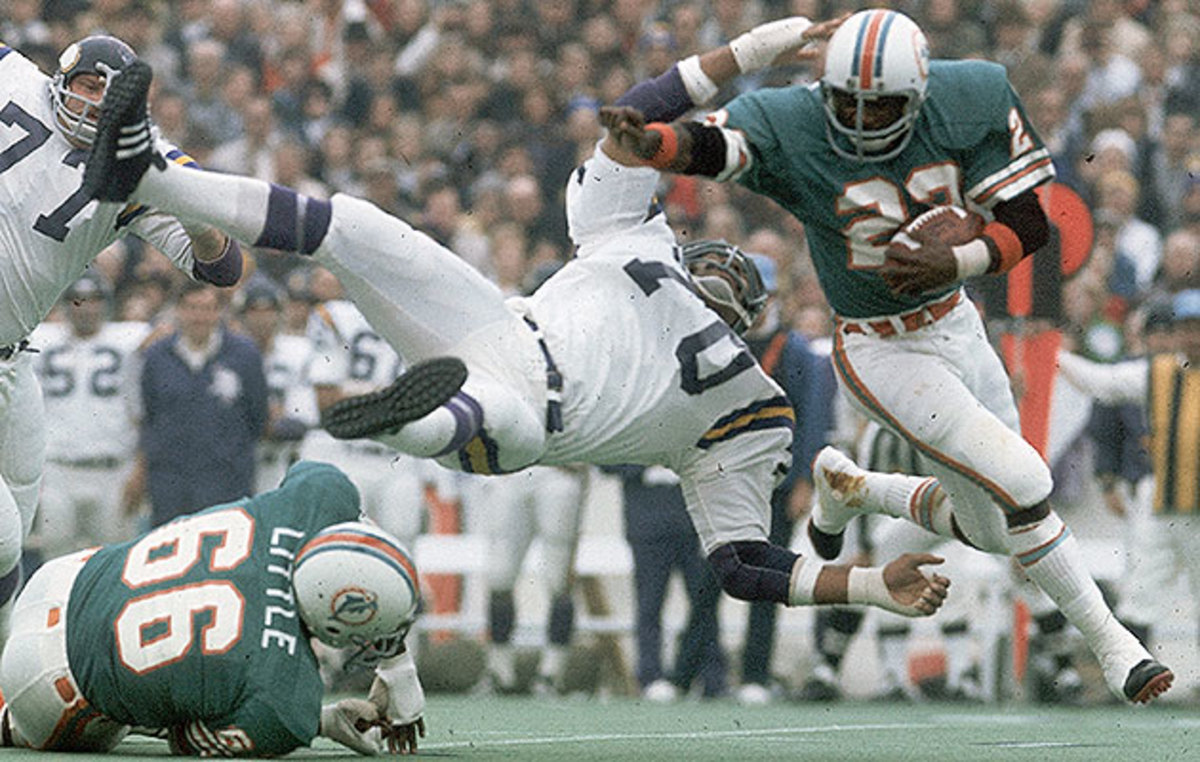The Borrowers: Panthers offense is built on the ideas of past champions

This story appears in the Feb. 8, 2016 issue of Sports Illustrated. Subscribe to the magazine online.
You might have heard that this year’s Super Bowl marks the golden anniversary of the Big Game. Come Sunday, you can expect to be hit repeatedly over the head with the history stick as throwback players (every living MVP) and throwback halftime performers (Beyoncé, Bruno Mars ...) are trotted out onto the field. To borrow from James Earl Jones in Field of Dreams, the memories will be so thick, you’ll have to brush them away from your face. Or something like that.
But look closely when the Panthers’ offense takes the field and the history lessons will keep coming at you.
Isn’t that the old Redskins’ counter trey?
I could have sworn that looked a lot like the famed Packers sweep.
Haven’t seen a team trap this much since the Dolphins and Steelers in the ’70s.
Beyond that, you’ll see elements of the title-hoarding 49ers of the ’80s (a draw play in regular down and distance, not just second-and-20?!) and even some of the outside zone stretch that Broncos head coach Gary Kubiak ran back when he was coordinating Denver’s offense to two Lombardi trophies in the late ’90s.
How Gettleman’s ‘hog mollies’ form core of Panthers’ Super Bowl team
If you’ve watched Carolina closely this season, you’ve seen all of these running elements—seemingly copy-pasted from old Super Bowl playbooks into the Panthers’ offense—and then some. Under coordinator Mike Shula and unheralded 24-year NFL line coach John Matsko, Carolina has made the old new again.
“That’s what good coaches do,” says Giants defensive coordinator Steve Spagnuolo, whose unit came as close as anyone outside of Atlanta to cracking the Panthers’ code, in a close Week 15 loss. “Let’s face it, nobody is inventing anything new anymore. We just beg, borrow and steal—or regurgitate something.”
But that’s selling Shula’s offense short. What elevates (and obscures) his throwback-bent O is that he dresses up old-school standards with new-school formations and accessories—from the zone read to the triple option to the jet sweep—that put quarterback Cam Newton’s vast array of talents in position to make plays and dictate how defenses can defend them.
“They’re taking classic NFL football—whether that be inside zone, outside zone, powers—and mixing in enough zone-read stuff so that when Newton [teases a handoff but then] pulls the ball in and keeps it, you have to have an answer for that,” says Jim McNally, who coached NFL offensive lines (including two Super Bowl teams) for 28 years. “That cuts down on a lot of blitzes and keeps the defense from being aggressive; it keeps the defense honest. Every last player on defense has to make sure he has that covered.”
“[The Panthers take] the old game of power football that all NFL teams have in their histories,” says retired line coach Alex Gibbs, a zone-blocking sage who worked with Kubiak in Denver's two Super Bowl wins, “and then they’re merging in a script out of college football, which Cam was outstanding running at Auburn, where you layer in a read-option concept. You don't see a lot of that in the NFL. It gets pretty complicated because they'll mix them both up.”
To better understand how Carolina pulls it off, let’s take a trip down memory lane.

Redskins: Counter Trey
In Super Bowl XXII, Washington led Denver 14–10 in the second quarter when coach Joe Gibbs dialed up one of his staple plays. The Redskins’ center, right guard and right tackle all blocked down to their left. While running back Timmy Smith took a jab step in the direction of that blocking, left guard Raleigh McKenzie and left tackle Joe Jacoby pulled to the right and joined tight end Clint Didier (who’d started in the backfield as a fullback) in forming a three-man wall, bulldozing toward the right side of the formation. Smith deftly cut back to the right and was barely touched on a 58-yard touchdown run that sent Washington on its way to a 42–10 blowout victory.
The All-22: Four matchups that could determine who wins Super Bowl 50
In the Panthers’ version of the counter trey—call it a counter duo, with a big ballcarrier (Newton; 6’5”, 245 pounds) who might as well be two people—the blocking and setup is different, but the spirit of the play remains. In the NFC Championship Game, Shula used it to break the Cardinals’ back late in the third quarter, when his team led 27–7. From shotgun, Newton looked and took a step toward running back Mike Tolbert to the left (which sent Arizona’s linebackers to protect against a screen), then ran toward the right end of the line. In front of him, right guard Trai Turner and center Ryan Kalil had pulled around the down blocking by the rest of the line and tight end Greg Olsen. Turner and Kalil picked off two defenders and Newton leaped into the end zone for a highlight-reel 12-yard touchdown.
Says Spagnuolo, who was watching at home: “I saw those guys pull and said to my buddy, ‘There's the counter trey—you don’t see that too often anymore.’ One advantage they have is that their center [Kalil] is really good. He can snap the ball and pull out and get there quickly enough. Not many [guys] can do that. It makes Carolina so much more dynamic.”
Packers: Sweep
While Green Bay was winning five NFL championships in the ’60s, including the first two Super Bowls, one of its staple plays was a variation of the old buck sweep. Coach Vince Lombardi would have his two guards pull in front of the running back to the right, while everyone else blocked down to the left (or heads-up). Just recounting it, you can almost hear the old coach’s voice echoing in your mind as he draws it up on the chalkboard: “Seal here, seal here—and he runs in the alley. ...”
Among the coaches who were seemingly entranced by those echoes over the years: Bill Walsh, who ran the old Packers sweep during his 49ers heyday, and Newton’s coach at Auburn, Gus Malzahn, who tailored a version that kept the ball in his QB’s hands. Later, when Cam arrived in Carolina, his first offensive coordinator, Rob Chudzinski, incorporated many of Malzahn’s old plays, including the sweep; and Shula kept many of those elements when he took over in 2013.
Josh Norman finds his weekly escape from football at a farm with his horse
Today the Panthers run the Packers’ sweep in a variety of ways, including with Newton on the ball. But midway through a 44–16 romp over the Redskins in Week 11, Carolina ran it with running back Jonathan Stewart. (“Shula has done a great job using all of his personnel,” says Alex Gibbs. “Everybody underrates Stewart; nobody seems to think he's all-star quality, but he is.”) On that play Newton tossed the ball to his right while two right-aligned receivers blocked down to the left. Right tackle Mike Remmers and Kalil pulled to the right in front of Stewart to give him an alley, and the result was a 10-yard gain.

Dolphins: Trap
The last time Miami won a Super Bowl, following the 1973 season, its backfield of Larry Csonka, Mercury Morris and Jim Kiick was so effective (51 rushes for 189 yards and three touchdowns) that quarterback Bob Griese only had to throw the ball seven times in a 24–7 victory over the Vikings.
In that game the Dolphins repeatedly used trap blocks (where an uncovered defender is allowed to get into the backfield, only to be picked off by a pulling blocker) to pummel Minnesota’s famed defensive line. On the first play of the second quarter, Miami let Hall of Fame left end Carl Eller come through unmolested. Eller didn’t see All-Pro left guard Bob Kuechenberg pulling, and he got blasted. Csonka provided the lead block through the hole while Morris scored on a 14-yard run.
“Everybody knew we were going to run and we ran anyway,” explains Kuechenberg. “We didn't do anything special, we just did it really well.”
Ex-Panthers GM Hurney spends his days praising the team that let him go
In a nutshell that’s Carolina’s offense: perfect execution by a steady group of running backs and linemen. And in what could be considered an homage to the great Dolphins teams that his father, Don, coached, Mike Shula employs a version of that trap multiple times per game, using Olsen in the fullback role (“Olsen’s a pretty cagey guy, pretty aware,” says Gibbs) and Turner as the pulling guard.
“The younger [coaches in the league] have never seen a trap,” says Bob Wylie, a former line coach with six NFL teams, who suggests that a move toward zone blocking in the late ’80s pushed the trap into obscurity. “The older coaches in the league remember.” So do their children.
The borrowing doesn’t stop there. The Panthers sprinkle in some of the outside zone stretch that Gibbs popularized with the Broncos (think: Terrell Davis running, shoulders pointed toward the sideline, looking for a lane), sometimes with a pin-and-pull element, where a tackle blocks down and the adjacent guard pulls behind him. And if you’re caught napping, Newton will channel Walsh’s San Francisco title teams and run a draw, with four blockers paving the way, as he did on a third-and-seven conversion in the fourth quarter against the Giants. (“Really should have been defendable,” says Spagnuolo, as he watches the daring play on a tablet. “Good call by them.”)
Shining light on the mostly ignored but not-so-easy job of a long snapper
In Santa Clara, the Broncos and their defensive coordinator Wade Phillips will have to prepare for all of those historically successful influences in the Panthers’ run game, but also keep an eye open for Shula’s modern wrinkles. Beyond the zone-read threat that Newton brings, Carolina also packages those runs with passes to the opposite side of the field, where Newton can throw if he likes the look. The Panthers will constantly have receivers in motion, sometimes winding up in the backfield, sometimes even getting the ball.
Yeah, it’s a lot.
“It is a really diverse running game. It is the most that we’ll see in the NFL,” Seahawks coach Pete Carroll said before his team fell behind the Panthers 31–0 at halftime in the divisional round, eventually losing 31–24. (Carolina’s 144 rushing yards that afternoon were more than any other team piled on Seattle this season.) “There’s nobody that does more stuff, and it’s basically because the quarterback is such a dynamic part of it. They’re willing to run [Newton] inside, outside, lead plays, powers, all of the read stuff as well. This is the most difficult offense that we face.”
Old plays. New wrinkles. Altogether, it adds up to big trouble for the Broncos.
